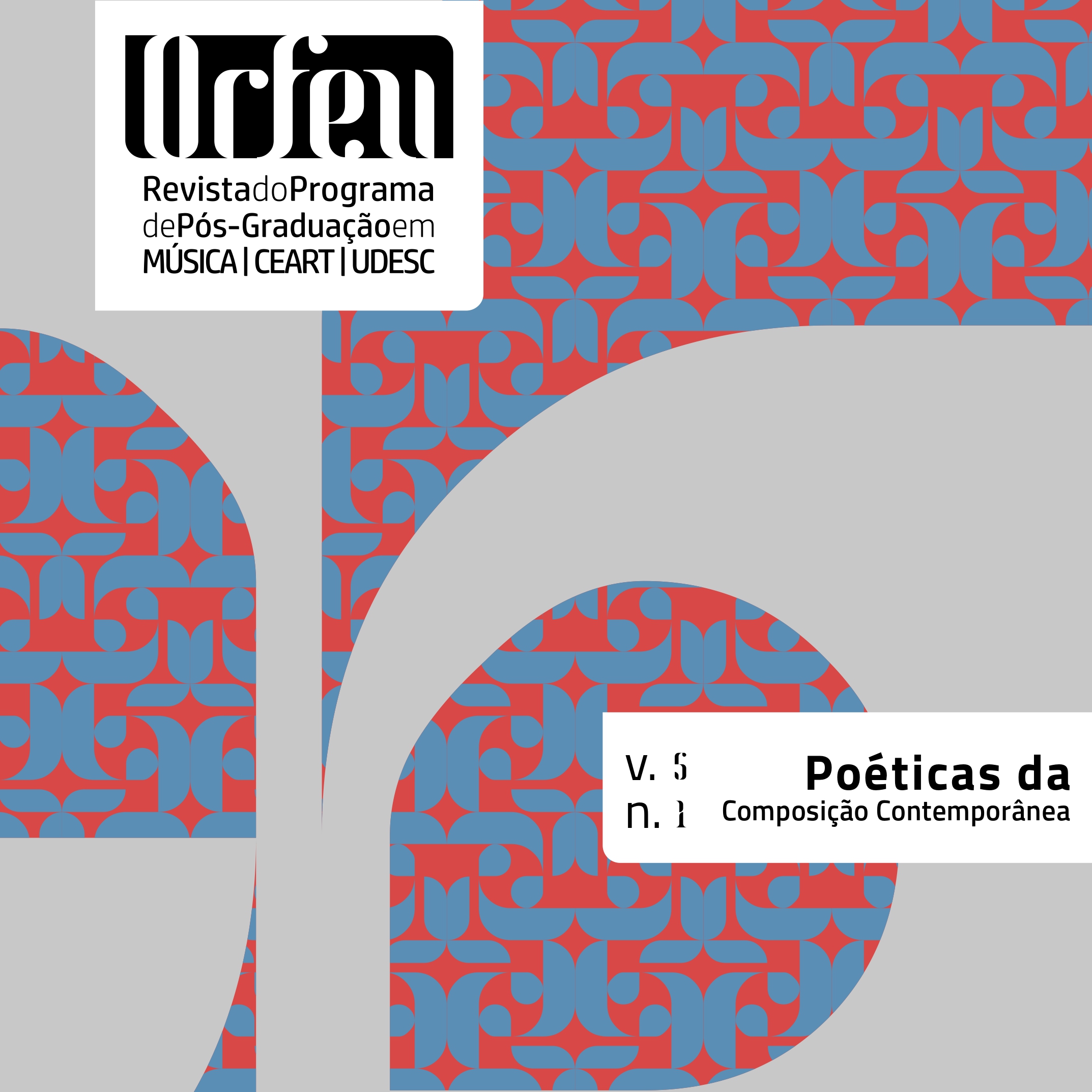INVISIBLE SOUNDS FOR CALVINO’S INVISIBLE CITIES: COLLABORATION IN A CREATIVE PROCESS
DOI:
https://doi.org/10.5965/2525530405012020554Parole chiave:
Artistic Research, Composition, Fortepiano, Invisible CitiesAbstract
Inspired by Italo Calvino's novel Le città invisibili (1972), which presents Marco Polo's description of several invisible and fictional cities, the authors embarked on an imaginary journey to create invisible sounds with the subtlety of the fortepiano. In a process akin to Calvino's novel, the article presents the comings and goings of an exchange process of ideas between the composer and the performer. Physically separated, in Brazil and Portugal, they used video conferences and e-mails to create the work. As the process evolved, technical aspects of the fortepiano and its peculiar sounds were intertwined with adjustments to the composer's creative writing. On the other hand, the combinatorial structure of Calvino's artwork anchored the exchange of musical materials among the work’s movements. This artistic-research project began in April 2014, and led to a recording of Sons Invisíveis (Invisible Sounds), included in the CD Música Nova for Antique Instruments II in 2016. In order to describe this trajectory, this article addresses recent literature in collaboration and performance studies, composition for historical instruments, particularly the fortepiano, the combinatorial nature of Calvino's writing, how the collaborative process was developed, and its final organization, expressing the ineffable character of Calvino's masterpiece through invisible sounds.
Downloads
Riferimenti bibliografici
ALLIS, M. Reading Music through Literature: Introduction. Journal of Musicological Research, v. 36, n. 1, p. 1-5, 2017. DOI: 10.1080/01411896.2016.1268900
CALVINO, I. Le città invisibili. Giulio Einaudi Editore, Italy, 1972.
CALVINO, I. Invisible Cities. Tradução William Weaver. San Diego: Harcourt Brave & Company, 1978.
CANNON, J. Literature as Combinatory Game: Italo Calvino’s The Castle of Crossed Destinies. Critique: Studies in Contemporary Fiction, v. 21, n. 1, p. 83-92, 1979. DOI:10. 1080/00111619.1979.9935198. ISSN 0011-1619.
COLE, M. The Pianoforte in the Classical Era. Oxford: Clarendon Press, 1998.
DEBRUN, M. Auto-organização e Ciências Cognitivas. In: GONZALES, M. E. Q.; LUNGARZO, C. A.; MILIDONI, C. B.; PEREIRA JR., A.; WRIGLEY M. B. (Org.). Encontro com as Ciências Cognitivas, Marília: Unesp, 1997. p. 27-34.
GENETTE, G. Palimpsests: Literature in the Second Degree. Translated by Channa Newman and Claude Doubinsky. Vol. 8. Lincoln: University of Nebraska Press, 1997.
HARRIS, P. A. Italo Calvino: the code, the clinamen and cities. Mosaic: An Interdisciplinary Critical Journal, v. 23, n. 4, Fall 1990. p. 67-85.
KRAMER, L. Classical music and postmodern knowledge. Berkeley: University of California Press, 1995.
KRAMER, L. After the lovedeath: sexual violence and the making of culture. Berkeley: University of California Press, 1997.
LO, C.-Y. Endangered Species: the harpsichord and its new repertoire since 1960. 200 f. PhD Thesis–University of Leeds, 2004.
MALUFE, A.; FERRAZ, S. Música e voz para além do som. Literatura e Sociedade, v. 19, n. 19), 2015. p. 149-167.
MANZOLLI, J. Auto-organização: um paradigma compositional. In: DEBRUN, M.; GONZALES, M. E. Q.; PESSOA JR., O. (Org.). Auto-organização: estudos interdisciplinares. Campinas: Coleção CLE 18, 1996. p. 417-435.
MARINHO, H.; BRANCO, J. The expanded fortepiano. In: SOVERAL, I.; POMBO, F. (Eds.). Synchresis Audiovision Tales. Aveiro: University of Aveiro, 2019. p. 207–212.
MARINHO, H.; CARRILHO, A.; AGUIRRE, J. Nova Música para Instrumentos Antigos II. Lisboa: Movimento Patrimonial pela Música Portuguesa, 2016. CD.
MARINHO, H.; CARVALHO, S. From Fortepiano to modern piano: a case study of a performer–composer collaboration. In: MARSHMAN, A. (Ed.). Performer’s voices across centuries and cultures. London: Imperial College Press, 2012. p. 177–189.
MORENO-VIQUEIRA, I. Invisible mathematics in Italo Calvino’s Le città invisibili. Thesis of Doctor of Philosophy–Graduate School of Arts and Sciences, Columbia University, 2013.
PALMER, L. Contemporary harpsichord music. In: KROLL, M. (Ed.). The Cambridge Companion to the Harpsichord. Cambridge: Cambridge University Press, 2019. p. 324–346.
SAWYER, K. Group Genius: the creative power of collaboration. New York: Hachette Book Group, 2017.
SCHER, S. P. Literature and Music. In: BARRICELI, J.-P.; GIBALDI, J. (Ed.). Interrelations of Literature. New York: Modern Language Association of America, 1982. p. 225–250.
SCHER, S. P. Essays on Literature and Music (1967–2004). Amsterdam: Rodopi, 2004.
ZUELICKE, K. The impermanence of obsolescence: performance practice challenges in works written for revival harpsichord. Doctoral Thesis–Victoria University of Wellington, 2017.
Downloads
Pubblicato
Come citare
Fascicolo
Sezione
Licenza
Copyright (c) 2020 ORFEU

TQuesto lavoro è fornito con la licenza Creative Commons Attribuzione 4.0 Internazionale.






